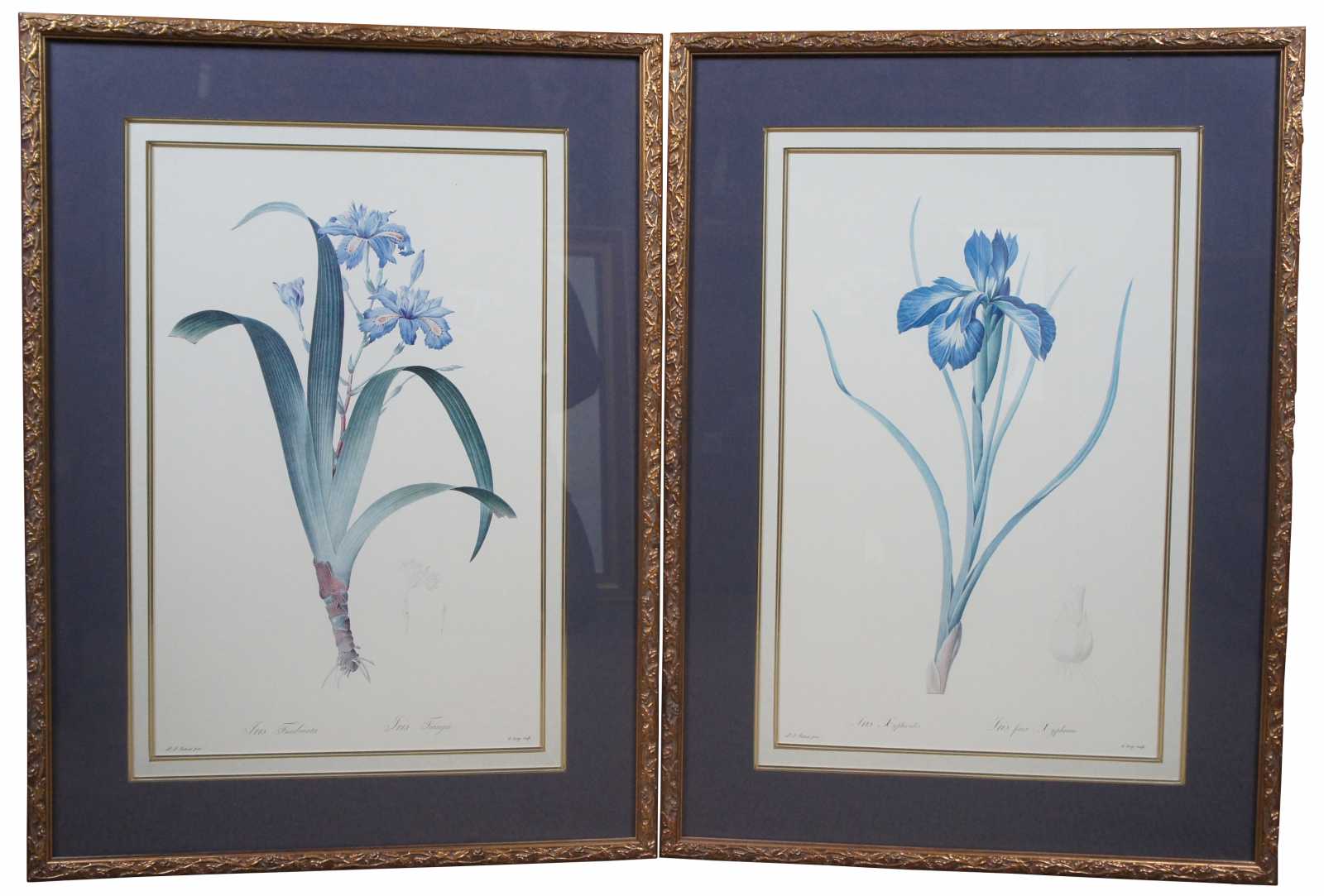
Shipping:
Free Shipping Included
Delivery:
Estimated 2-15 Business Days
Payments:
Credit Card, Check, Cash, PayPal, Apple Pay, Venmo
Returns:
30 Days 100% Money Back Guarantee, Buyer Pays Return Shipping
Description
Pair of framed reproduction botanical prints showing the Iris Fimbriata and Iris Xyphiodes by Pierre-Joseph Redoute. “Pierre-Joseph Redoute was a Belgian painter and botanist, known for his watercolours of roses, lilies and other flowers at Malmaison. He was nicknamed ""The Raphael of flowers"".
He was an official court artist of Queen Marie Antoinette, and he continued painting through the French Revolution and Reign of Terror. Redoute survived the turbulent political upheaval to gain international recognition for his precise renderings of plants, which remain as fresh in the early 21st century as when first painted.
Paris was the cultural and scientific centre of Europe during an outstanding period in botanical illustration (1798 - 1837), one noted for the publication of several folio books with coloured plates. Enthusiastically, Redoute became an heir to the tradition of the Flemish and Dutch flower painters Brueghel, Ruysch, van Huysum and de Heem. Redoute contributed over 2,100 published plates depicting over 1,800 different species, many never rendered before.
Redoute was born in Saint-Hubert, Luxembourg; the town is now in Belgium. Although he was relatively lacking in formal education, both Redoute's father and grandfather were painters. He left home at the age of 13 to earn his living as an itinerant Belgian painter, doing interior decoration, portraits and religious commissions.
In 1782 Redoute joined his elder brother, Antoine Ferdinand, an interior decorator and scenery designer in Paris. There he met the botanist and book lover Charles Louis L'Héritier de Brutelle, and René Desfontaines, who steered him towards botanical illustration, a rapidly growing discipline.
In 1786 Redoute began work at the Muséum national d'histoire naturelle cataloguing the collections of flora and fauna and participating in botanical expeditions, notably Bonaparte's Egyptian expedition. In 1787, he left to study plants at the Royal Botanic Gardens, Kew near London.
In 1788, Redoute returned to Paris. In 1792 he was employed by the French Academy of Sciences. Cheveau, a Parisian dealer, brought the young artist to the attention of the botanical artist Gerard van Spaendonck at the Jardin du Roi, which became the Jardin des Plantes of the Muséum national d'histoire naturelle in 1793, after the Revolution. Van Spaendonck became Redoute's teacher, L'Heritier his patron, who taught him to dissect flowers and portray their diagnostic characteristics. L'Heritier also introduced Redoute to members of the court at Versailles. Marie Antoinette became his patron. Redoute received the title of Draughtsman and Painter to the Queen's Cabinet.
In 1798, Empress Joséphine de Beauharnais, the first wife of Napoleon Bonaparte, became his patron and, some years later, he was her official artist. In 1809, Redoute taught painting to Empress Marie-Louise of Austria.
After Josephine's death, Redoute's fortunes fell until he was appointed as a master of design for the Museum d'Histoire Naturelle in 1822. In 1824, he gave some drawing classes at the Muséum national d'histoire naturelle. He taught many female royal personages, mostly Belgian. He became a Chevalier of the Légion d'honneur in 1825. Although particularly renowned for his botanical exploration of roses and lilies, he thereafter produced paintings purely for aesthetic value including those of the celebrated Choix des plus belles Fleurs.
Redouté was capable of overcoming successive political crises, without great struggle, and surviving survive under different political régimes. He collaborated with the greatest botanists of his day and participated in nearly fifty publications. Over his long career, Redoute painted the gardens at the Petite Trianon of Marie Antoinette as her official court artist. During the French Revolution and Reign of Terror, he was appointed to document gardens which became national property. However, during the patronage of the generous Empress Josephine, Redoute's career flourished and he produced his most sumptuous books portraying plants from places as distant as Japan, South Africa and Australia as well as Europe and America.
He died on 19 or 20 June 1840 and was interred in Père Lachaise Cemetery.
A Brussels school bears his name: the Institut Redouté-Peiffer in Anderlecht”
Condition
Very Good - See pictures
Dimensions
22.25” x 0.75” x 30.25” / Sans Frame - 13.5” x 21.5” (Width x Depth x Height)